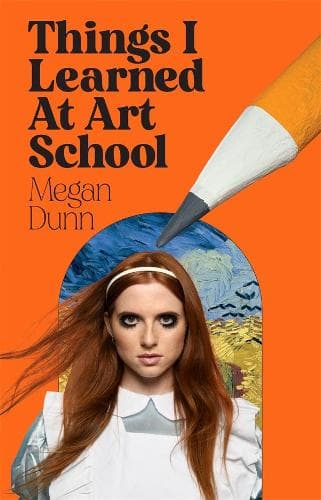Review: Things I Learned at Art School
Reviewed by Hannah Tunnicliffe
Megan Dunn’s pumpkin-orange Things I Learned At Art School is a memoir and essay collection that is reflective, hilarious and discordant. The mostly chronological collection covers a lot of ground including descriptions of Megan’s childhood, her parent’s separation, a brief stint living in Huntly, the unexpected comforts of living above an old people’s home, her favourite kids’ toys from the 1980s, high school bullies, studying at Elam Arts School and working at Showgirls.
Dunn is my vintage – born in the ‘70s, obsessed with Strawberry Shortcake, Alf and My Little Ponys in the ‘80s, brazen, confused, drunk and wearing animal print in the ‘90s and unpicking and assessing it all during the last two decades. Some of Dunn’s best stories explore the interwoven elation and awfulness of “coming of age” including, my favourite, her description of her first pash: “It was like being part of the apparatus that makes a slushy.”
Dunn is the master of quips and puns. Essays that explore failure, longing and grief are seasoned with the kind of humour that would make David Sedaris grin. While she scaffolds some of her essays with research and facts they are all deeply personal and self-deprecating. Even her essay titles bristle with sarcasm – Life Begins at Forty: That Time my Uncle Killed Himself and List of Guys I Had Sex With When I Worked in the Sex Industry (Short List, Long Shifts). Dunn sets scenes beautifully – “The flat was the size of a hiccup” or “The bus stop at the end of Kelly’s street was feijoa green and had an aroma of loitering” – but her jokes are the instant wins.
Like this one, perfectly capturing her father’s house by the sea and her aching loneliness: “The house was besieged by wind and the brick driveway assailed by sand. But, in the lounge, we were warm and the Kent wood fire was stoked, even if I wasn’t.” The only jokes that fall flat are the fat ones. Or, more broadly, ones about appearance: blokes with bad teeth or podgy white bellies and a whole chapter titled CV of a Fat Waitress which felt a bit mean and unnecessary (especially when Dunn has legitimate humour in abundance). Like Monica Geller in Friends wearing a fat suit, they are a genre of cheap lols I’d prefer were left in our past.
Family, especially Dunn’s mother Lee, and friends, including Yvonne Todd who created the red-haired Alice in Wonderland cover art, feature heavily. Dunn recounts their shared misdemeanours, misadventures and victories alongside her own and is unafraid to admit mistakes, flaws and fallouts.
In parts Dunn’s writing is so personal it can read like an inside-joke and at times feels slightly shambolic. But even that is something Dunn understands about herself. In Things I Learned at Art School she laments to her Masters of Creative Writing tutor that she writes in fragments. The wise tutor responds: “You write in fragments. Great,’ she said. ‘Make the problem part of the subject.’”
And Dunn has done exactly that. She has taken her fragments and made art – enthusiastically juxtaposing love, loss, metaphors, art, popular culture, disappointment, irony, grit and wry comedy and doesn’t promise to resolve any of it. She does a deep-dive into the world of The Smurfs and places it right next to adultery in a black waterbed; the forgotten recipe for a Showgirls “Frosted Pussy” cocktail followed by an essay about a mental collapse. It’s sometimes hard to keep up with Dunn’s writing and her essays are often inconclusive but they are sharp, witty and relatable.
To thieve Dunn’s description of Huntly from the second chapter – two things happen in this book: something and nothing. Sometimes it hard to tell which is which. Luckily, it doesn’t matter because in Dunn’s hands they both make for great reading.
Reviewed by Hannah Tunnicliffe
